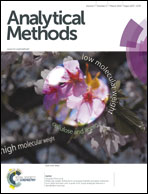Identification of heavy metal-contaminated Tegillarca granosa using infrared spectroscopy
Abstract
This study explored the feasibility of using infrared spectroscopy for the rapid detection of heavy metal contamination in Tegillarca granosa. Generally, there is no specific characteristic peak of heavy metals in the infrared range. However, certain changes in the structure and concentration of relevant biological molecules induced by heavy-metal contamination produce spectral information, albeit the signals are very weak. In this study, we selected characteristic infrared spectral variables to obtain heavy metal information using the competitive adaptive reweighted sampling method, successive projection algorithm and genetic algorithm. The selected variables served as inputs for the classification algorithm to construct two classification models. One model was designed to classify Tegillarca granosa samples that were uncontaminated (healthy) and contaminated by a certain heavy metal (Cu, Cd, Pb, or Zn) (Design I). The other model was designed to classify all sample varieties, including uncontaminated samples and those contaminated by the four heavy metals (Design II). The two models were validated using 10-fold cross validation. The prediction accuracy by combining the competitive adaptive reweighted sampling method and support vector machine algorithm reached 95% for Design I and 92% for Design II. The results of this study indicated the potential of infrared spectroscopy in evaluating heavy-metal contamination in Tegillarca granosa.


 Please wait while we load your content...
Please wait while we load your content...